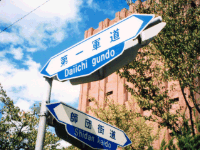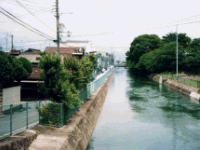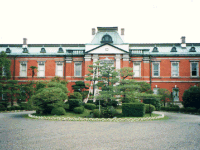Daiichi Gundo(First Military Road)
|
From the end of Meiji (about 1912 AD) to the end of the WWII (1945 AD), the presence of extensive military facilities created such
military terms as "Shidan Kaido" (The Division Road), "Gundo" (Military Road) and others that since inappropriately become a part
of this peaceful town.  A “division” is a military unit that consists of the infantrymen, troopers, artillerymen, engineers and
suppliers (who are engaged in the supply of ammunitions and food, and the transportation of troops and equipment); so a division is
a self-sufficient unit in time of war.
A “division” is a military unit that consists of the infantrymen, troopers, artillerymen, engineers and
suppliers (who are engaged in the supply of ammunitions and food, and the transportation of troops and equipment); so a division is
a self-sufficient unit in time of war.Based on the experience of the Russo-Japanese War and the need for substantial military expansion, the Japanese government decided at that time to establish "the Sixteenth Division of Japanese Army" in November of 1908 at this place. And so a number of military roads with many military facilities were constructed here. To secretly and quickly transport soldiers, weapons and ammunitions, the road called "Division Road (Shidan Kaido)" was constructed from Kyoto-station that headed east along Shiokoji Street and crossed Kamogawa river through a small vacant lot between the canal and Kamogawa river to the Division. Because Fushimi canal and Keihan Line ran on the east side of the Division Road before the 16th Division was established, viaducts were needed to connect various military units and facilities on both sides of the Division Road. Thus, three military roads with viaduct were constructed. "The first military road" is the east-west road on the south side of Sunagawa Elementary School; a sign of "Shidankaido/Daiichi Gundo (Division Road/First Military Road)" is displayed at the southeast corner of Ryukoku University. "The second military road" was an important road as it directly connected the division headquarters. It used to be a short east-west road where the north exit of Fujimori Daiei was located and is now where an apartment building stands. The viaduct that the second military crosses over the canal is still called "Shidanbashi (Division Bridge)", and the "☆" symbol is visible at the top of the pier. "The third military road" goes from the southeast square of the Kyoto Municipal Science Center For Youth to Yamashina through the north side of the National Hospital Organization Kyoto Medical Center. "The Kyoto Weapon Stock Yard (Kyoto Heiki Sisho)" had been a military facility, but is now the site of the Police Academy and Ryukoku University. Weapons arriving at Kyoto station were temporarily stored here and distributed to each army unit as needed. On the south of the Kyoto Weapon Stock Yard was "Kyoto Renpeijyo (The Military drill ground)" which was also used as an airport before. Kyoto Renpeijyo was a large open space of about seven hundred meters from east to west and about eight hundred meters from north to south, and consisted of nine towns before it was purchased by the army.  However, this area was sold back to the public after the WWII, and becomes the current "Nishiuracho (Nishiura Town)".
However, this area was sold back to the public after the WWII, and becomes the current "Nishiuracho (Nishiura Town)".Further south, are located Kyoto Municipal Science Center For Youth and Fujimori Junior High school where the barracks of "Houhei Dai 22 Rentai (The 22nd Regiment of Artillery)" used to be. Every day at noon at the same time, the artillerists practiced pulling out the cannon to the drill ground and fire blank cannon as a time signal. The fired blank cannon could be heard so far away that people called it "Fushimi No Dohn (The Bang of Fushimi)". The military garrison hospital is still at the place where National Hospital Organization Kyoto Medical Center is presently constructed.  The site of the sixteenth divisional headquarters is now occupied by
the Holy Mother Academy with its matching red brick building and green pine garden - creating the calming atmosphere most suitable for
a girls’ school.
The site of the sixteenth divisional headquarters is now occupied by
the Holy Mother Academy with its matching red brick building and green pine garden - creating the calming atmosphere most suitable for
a girls’ school. The official dwelling of the sixteenth division commander still remains; this area, managed by the Ministry of Finance and not by the Holy Mother Academy, has become the official residence of the Defense Agency. The famous sixteenth division commanders were Kesago Nakashima who commanded the Nanjing capture and Kanji Ishihara who was responsible for the Japanese Army when the Manchurian incident happened. This division fought a terrible battle at Leyte - killing and starving a lot of people at the end of the war. Walk around the “War Relics” in Kyoto Written by Ichiro Ikeda & Tetsuya Suzuki, members of the Kyoto War Exhibition for Peace Executive CommitteeTsumugi Publishing Issue. |
|
| Thanks to Mr. D.M. |